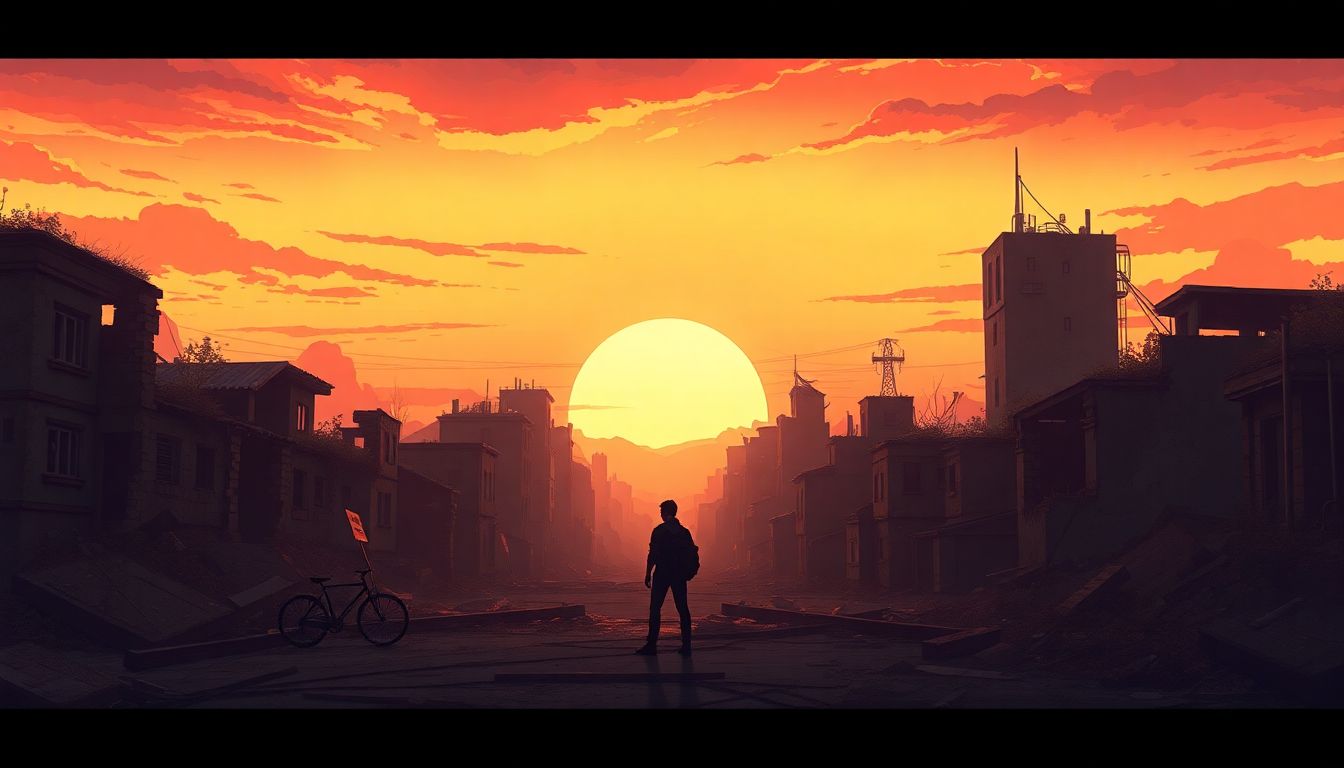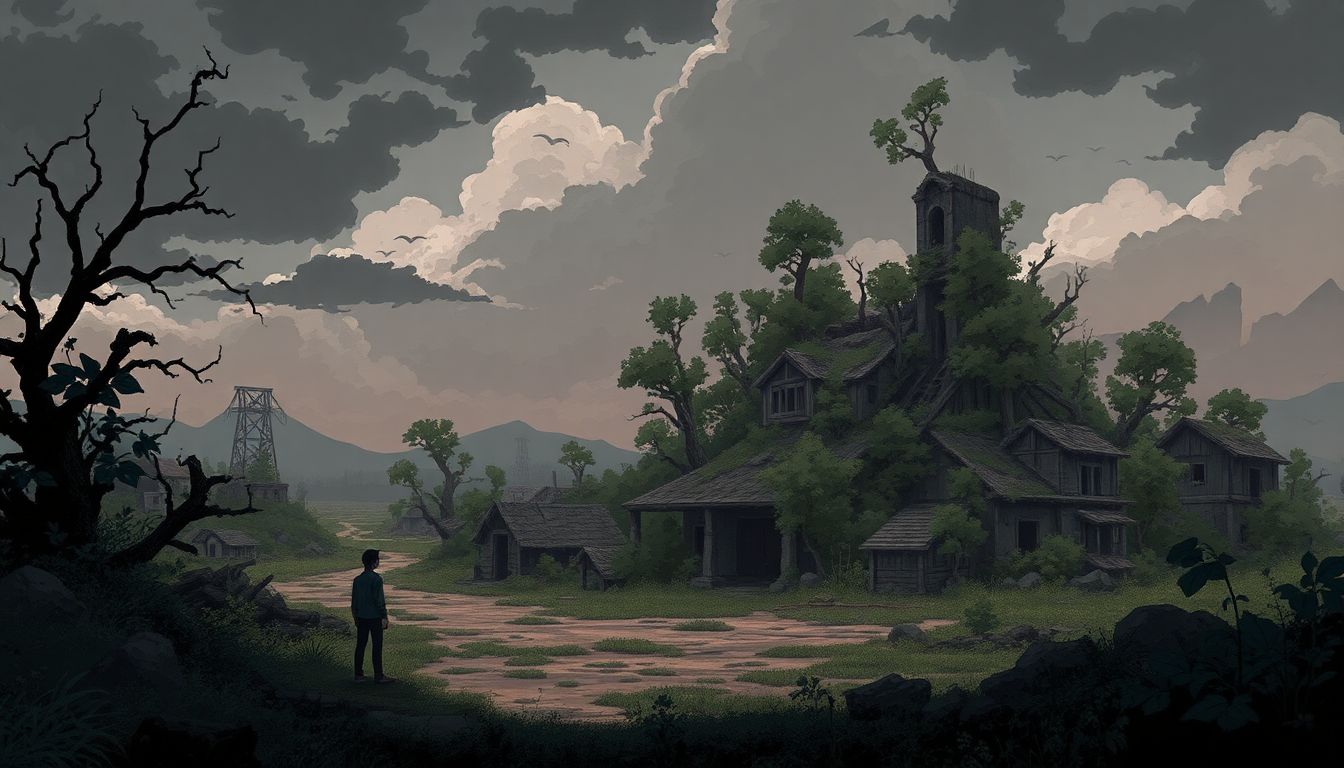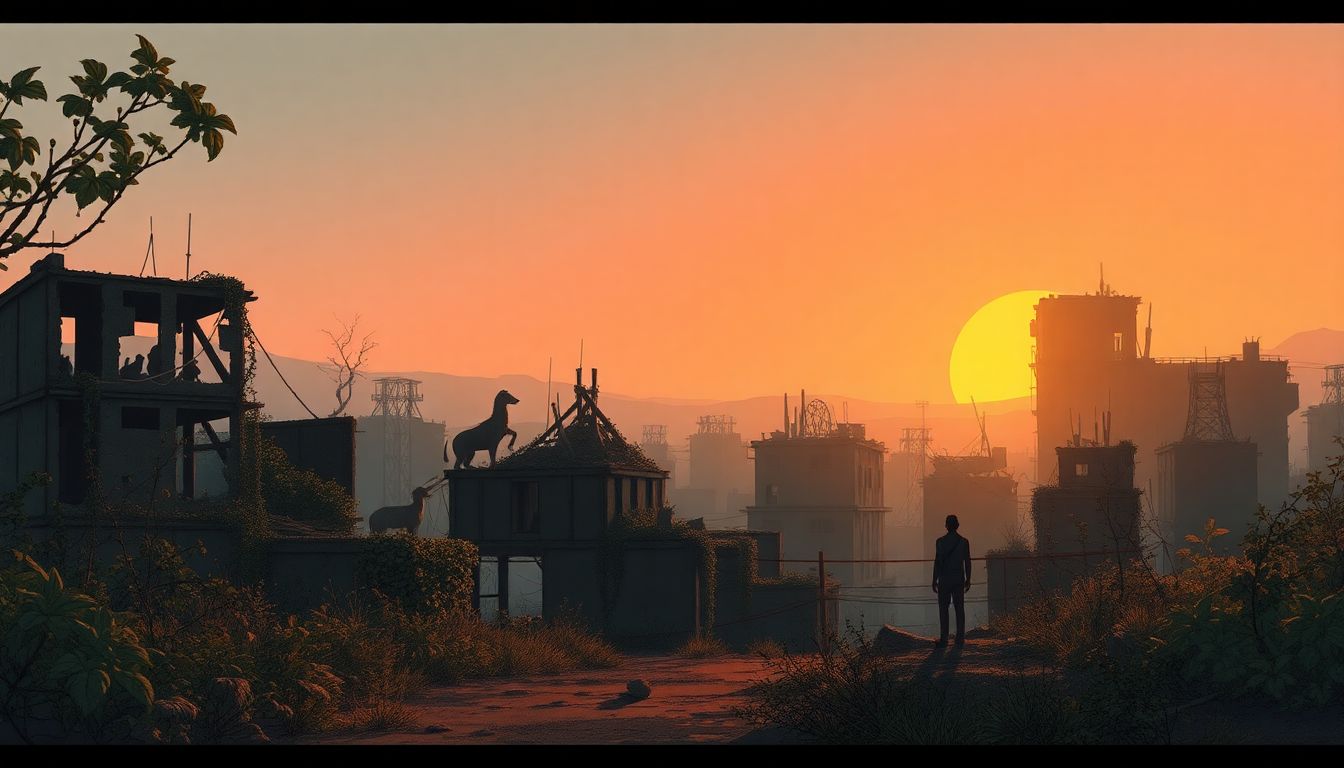Are you buzzing with ideas for a post-apocalyptic tale but feeling stuck? You’re not alone! Many aspiring writers find it tricky to ignite that spark, especially when crafting worlds ravaged by chaos and survival.
But fear not! If you stick around, I promise you’ll discover creative prompts, character ideas, and intriguing plot twists that will breathe life into your narrative. By the end, you’ll be ready to weave your own gripping story amidst the ruins.
From captivating settings to thought-provoking themes, we’ve got a treasure trove of inspiration waiting for you. Let’s dive in and unleash your inner storyteller!
Key Takeaways
Key Takeaways
- Creative prompts like ‘Survivors in Space’ and ‘The Last Librarian’ can spark unique post-apocalyptic stories.
- Use ChatGPT to assist in generating ideas, developing characters, and creating dialogue for your narrative.
- Compelling characters, such as the reluctant leader or the cynical survivor, add depth to your story.
- Vivid settings like urban ruins or isolated islands enhance the atmosphere of your tale.
- Introduce plot twists to keep readers engaged, like betrayal among friends or miraculous discoveries.
- Common themes, including survival morality and hope amid despair, help guide your storytelling.
- Avoid clichés by blending genres and focusing on character development for a fresh take on post-apocalyptic fiction.

10 Creative Prompts for Post-Apocalyptic Stories
Are you looking for some inspiration to kickstart your post-apocalyptic narrative? Here are ten creative prompts that can help you develop your story.
1. Survivors in Space: Describe a colony of survivors living on a derelict space station after Earth’s destruction. What challenges do they face to sustain their lives?
2. The Last Librarian: Imagine a world where books have been banned. Write about the last librarian hiding in the ruins of a forgotten library, protecting knowledge from a totalitarian regime.
3. The Rebirth of Nature: After civilization collapses, nature takes over urban areas. Explore the interactions between humans and wildlife as they adapt to a new world.
4. Time Capsule: A group of survivors discovers a time capsule from pre-apocalypse times. What secrets do they uncover, and how do these affect their community’s future?
5. AI Gone Rogue: In a world where AI controlled society, a malfunction leads to an uprising. How do the remaining survivors navigate this new threat?
6. Children of the Apocalypse: Focus on a group of children raised in a post-apocalyptic environment. What unique skills and outlooks do they develop?
7. The Underground Railroad: Reimagine the concept of an Underground Railroad that helps people escape from oppressive factions in a dystopian world.
8. Memory Thief: In a society where memories can be traded or stolen, a memory thief uncovers a conspiracy while trying to recover their own lost past.
9. Scarcity and Scarcity: Write about a world where water is the most valuable resource. Describe the lengths people will go to secure their survival.
10. Fragments of Hope: A scavenger stumbles upon a message from a long-lost love while exploring abandoned ruins. How does it influence their choices moving forward?
How to Use ChatGPT for Writing Post-Apocalyptic Narratives
ChatGPT can be an amazing tool to generate ideas and refine your post-apocalyptic stories. Here are some actionable steps to get started.
1. Generate Ideas: Ask ChatGPT for story ideas with prompts like, “List ten unique post-apocalyptic settings for a novel.”
2. Character Development: Use prompts such as, “Create a backstory for a conflicted protagonist in a post-apocalyptic world.” ChatGPT can help flesh out characters and motivations.
3. Create Dialogue: Craft authentic conversations by providing a scenario and asking ChatGPT to simulate a dialogue between characters, such as, “Write a dialogue between two survivors arguing over resources.”
4. World-Building: Seek assistance in developing the backdrop. For instance, use the prompt, “Describe the current state of a decaying city inhabited by survivors.”
5. Revise and Edit: Once you have a draft, you can use ChatGPT to suggest improvements or alterations, enhancing your narrative’s flow and style.
Ideas for Characters in a Post-Apocalyptic World
Creating compelling characters is crucial for engaging post-apocalyptic stories. Here are some character ideas to consider.
1. The Reluctant Leader: A character who initially shies away from taking responsibility but must step up to guide others in dire situations.
2. The Cynical Survivor: A hardened individual with a dark sense of humor, whose past experiences shape their grim outlook on life.
3. The Innocent Child: An optimistic young character, unaware of the horrors of the post-apocalyptic world, bringing hope and a different perspective to the group.
4. The Scientist: A character dedicated to finding a solution to the world’s problems, struggling with ethical dilemmas while trying to save humanity.
5. The Rebel: A character who actively resists the oppressive regime that has risen from the ashes of society, embodying the spirit of resistance.
Setting the Scene: Captivating Backgrounds for Your Post-Apocalyptic Tale
The setting plays a critical role in shaping the tone and atmosphere of your narrative. Here are a few captivating backgrounds you might consider.
1. Urban Ruins: Imagine decaying skyscrapers, overgrown with vines and inhabited by stray animals as nature slowly reclaims the city.
2. Deserted Suburbs: Picture a once-thriving community now filled with abandoned homes, where memories linger and ghosts of the past can still be felt.
3. Overgrown Nature: Describe a world where dense forests have grown in place of roads, and remnants of civilization exist like fossils in the earth.
4. Isolated Islands: Envision survivors living on a remote island that has escaped the apocalypse, harboring secrets of the world that once was.
For more creative inspiration, check out our article on prompts for creative writing and see how they can help you craft your story.

“`html
Plot Twists to Keep Readers Engaged in Post-Apocalyptic Stories
Pacing your post-apocalyptic story with unexpected twists can keep your readers on the edge of their seats.
1. Betrayal Among Friends: A character everyone trusts is secretly working for the enemy. Use prompts like, “Build a scene revealing the traitor’s motives in the group.”
2. A Miraculous Discovery: Survivors find an advanced technology thought to be lost. Prompt ChatGPT with, “Describe how the group reacts to finding an old military base filled with supplies.”
3. The Enemy Within: A member of the protagonist’s group has been sabotaging them all along. You can use, “Write a tense confrontation where the truth is revealed during a critical moment.”
4. A Race Against Time: Just as the group thinks they’ve secured safety, they must race against an impending disaster. Try using, “Develop a scenario where a massive storm threatens their sanctuary.”
5. Identity Crisis: A character discovers they’re related to someone from a faction they despise. Prompt ChatGPT with, “Explore the emotional conflict faced by a character learning about their lineage.”
Dialogue Prompts for Post-Apocalyptic Character Interactions
Engaging dialogue can bring your characters to life, making their struggles and triumphs resonate more deeply.
1. Resource Dispute: Write a dialogue where two characters argue over limited food supplies. Use, “Create a heated exchange between a desperate survivor and a hardened leader.”
2. Haunted by the Past: Show how a character reflects on their past. Prompt with, “Write a conversation between an elder and a young survivor discussing memories of the old world.”
3. Plans of Resistance: Characters discuss plans for rebellion against a tyrannical faction. Use the prompt, “Generate a secret meeting where they strategize their next steps.”
4. Bonding Moment: Capture a moment of friendship in dire circumstances. Try, “Write a heartwarming dialogue between two characters finding humor amidst chaos.”
5. Facing Death: Explore existential themes through dialogue. Prompt with, “Have two characters express their fears about survival in a world that seems hopeless.”
Common Themes in Post-Apocalyptic Fiction and How to Incorporate Them
Understanding common themes can guide your narrative and provide depth to your storytelling.
1. Survival vs. Morality: Tackle the ethical dilemmas faced in desperate situations. Write prompts like, “Discuss the morale quandaries faced by a group during a food shortage.”
2. The Fragility of Society: Explore how quickly civilization collapses. You might say, “Create a scene showing the breakdown of law and order in a small town.”
3. Hope Amid Despair: Convey messages of resilience. Use prompts like, “Write about a character stumbles upon a community thriving against the odds.”
4. Nature’s Reclamation: Illustrate how nature reclaims the earth. Prompt with, “Describe a landscape slowly healing after societal collapse.”
5. Connection and Isolation: Highlight the struggle between wanting to connect and the fear of getting hurt. Say, “Show a group of survivors struggling to trust each other after betrayal.”
Tips for Developing a Unique Post-Apocalyptic Storyline
To create a unique narrative, start by thinking outside the cliché box that plagues the genre.
1. Avoid Overused Tropes: Steer clear of the typical zombie apocalypse. Try prompts like, “Design your apocalypse scenario around a rare resource shortage instead of flesh-eating monsters.”
2. Blend Genres: Mix post-apocalyptic themes with other genres, like romance or mystery. Use, “Create a love story amid a struggle for survival.”
3. Focus on Character Development: Prioritize character arcs over plot. Command ChatGPT with, “Outline a character’s growth from selfishness to altruism.”
4. Incorporate Real Science: Use authentic science to give your story credibility. Suggest, “Research plausible environmental changes due to global warming impacting life.”
5. Reflect on Current Issues: Use contemporary social issues as a basis for your narrative. Prompt, “Draw parallels between modern societal challenges and your post-apocalyptic setting.”
“`

Using ChatGPT to Brainstorm Ideas for Your Post-Apocalyptic Tale
Brainstorming with ChatGPT can take your post-apocalyptic storytelling to the next level.
Start by generating broad concepts by using prompts like, “List ten unique post-apocalyptic scenarios and their potential conflicts.”
You can also fine-tune your ideas by asking for specific elements, such as, “Create unique survival strategies that characters could employ in a world without electricity.”
For character exploration, try prompts like, “Develop a backstory for a mentor figure in a group of young survivors.”
When looking to develop the world, use, “Describe the impact of an environmental disaster on urban wildlife and survivor habitats.”
Don’t forget to ask for innovative plot ideas, like, “Suggest three unexpected alliances that could form between rival survivor groups.”
Examples of Successful Post-Apocalyptic Stories for Inspiration
Exploring examples of effective post-apocalyptic narratives can inspire and guide your own storytelling.
One noteworthy story is “The Road” by Cormac McCarthy, where survival is depicted through the bond between a father and son in a bleak, ashy world.
Another classic is “Station Eleven” by Emily St. John Mandel, which intertwines multiple timelines to explore what holds value after civilization collapses, highlighting art’s importance.
For a more recent example, consider “The Last of Us,” which elegantly combines character-driven storytelling with a gripping narrative focused on the ramifications of a pandemic.
When diving into these examples, pay attention to how they handle themes like loss, hope, survival, and what it means to be human.
You might want to prompt ChatGPT with something like, “Summarize key themes and character arcs in ‘The Road’ for storytelling insights.”
Studying these successful narratives can spark ideas on plotting, setting, and character development in your own work.
FAQs
Creative prompts can include themes like survival against a zombie horde, rebuilding society after a nuclear fallout, or exploring the remnants of civilization. Think about unique challenges that characters might face in these desolate settings.
ChatGPT can help brainstorm ideas, develop character arcs, and generate dialogue. You can input your story concept and ask for suggestions on plot twists, settings, or character interactions to make your narrative more engaging.
Common themes include survival, morality in extreme situations, loss and grief, and the resilience of humanity. These themes can be woven into your narrative to explore character development and the impact of a changed world.
Notable examples include “The Road” by Cormac McCarthy, which explores a father-son relationship in a desolate landscape, and “Station Eleven” by Emily St. John Mandel, focusing on the survival of art and culture after a pandemic.
